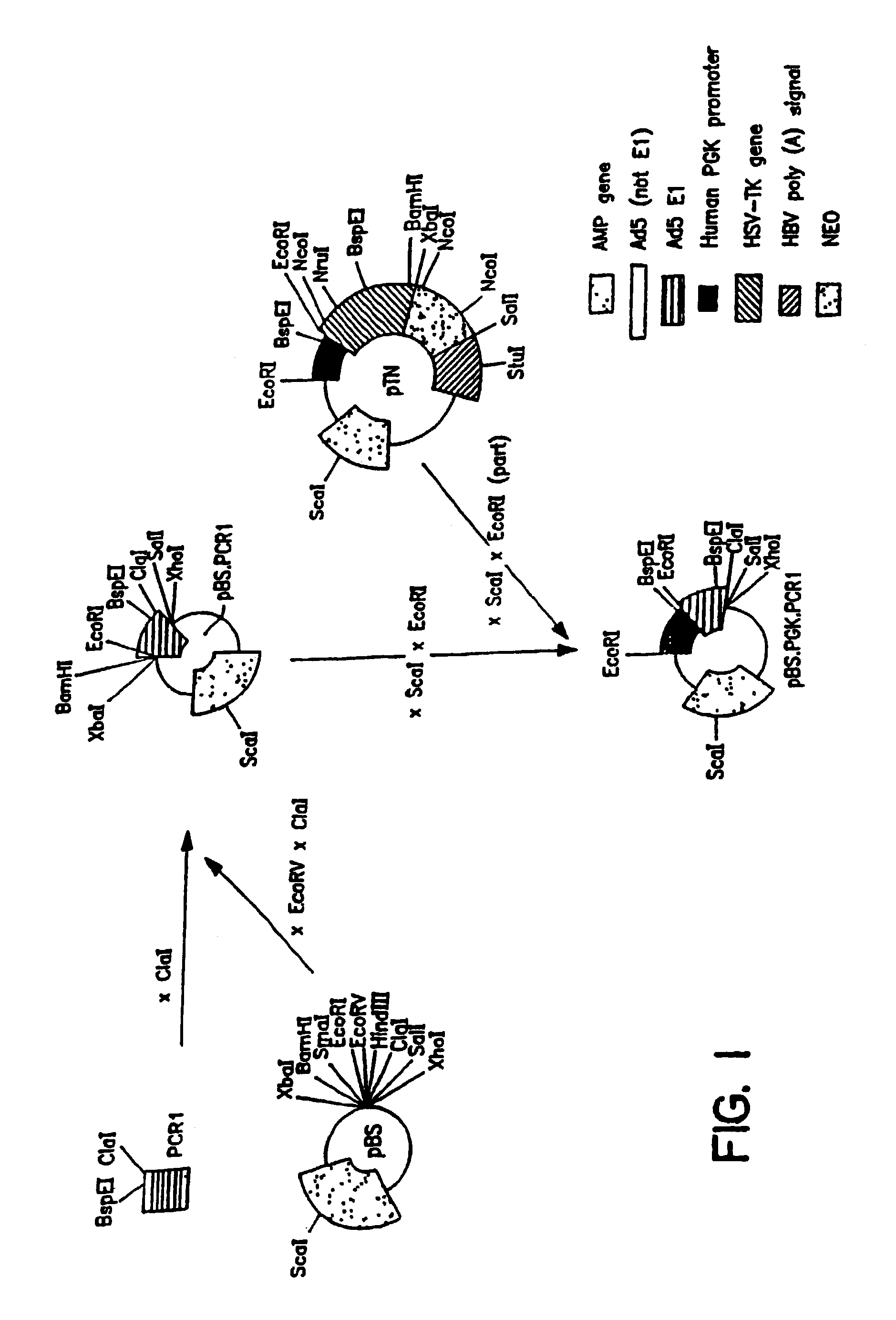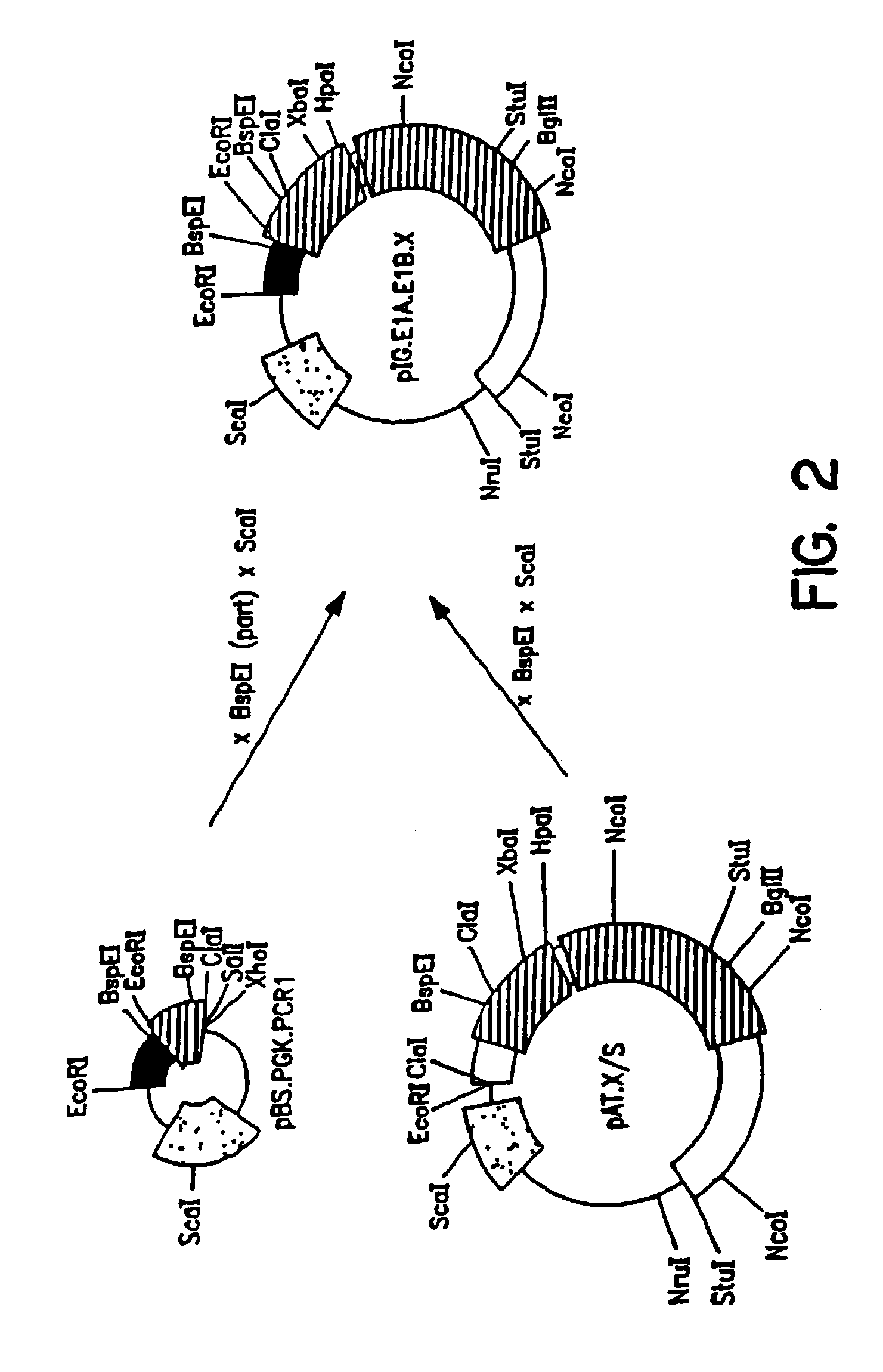Packaging systems for human recombinant adenovirus to be used in gene therapy
- Summary
- Abstract
- Description
- Claims
- Application Information
AI Technical Summary
Benefits of technology
Problems solved by technology
Method used
Image
Examples
example 1
Generation of Cell Lines Able to Transcomplement E1 Defective Recombinants Adenovirus Vectors
1. 911 Cell Line
[0113]A cell line that harbors E1 sequences of adenovirus type 5, able to trans-complement E1 deleted recombinant adenovirus has been generated, (Fallaux et al, (1996) Hum. Gene Ther. 7:215–222). This cell line was obtained by transfection of human diploid human embryonic retinoblasts (HER) with pAd5XhoIC, that contains nt. 80–5788 of Ad5; one of the resulting transformants was designated 911. This cell line has been shown to be useful in the propagation of E1 defective recombinant adenovirus. It was found to be superior to the 293 cells. Unlike 293 cells, 911 cells lack a fully transformed phenotype, which most likely is the cause of performing better as adenovirus packaging line. For example, plaque assays can be performed faster (4–5 days instead of 8–14 days on 293) monolayers of 911 cells survive better under agar overlay as required for plaque assays higher amplificatio...
example 2
Plasmid-based System for Rapid RCA-free Generation of Recombinant Adenoviral Vectors
A. Construction of Adenovirus Clones
pBr / Ad.Bam-rITR (ECACC Deposit P97082122)
[0146]In order to facilitate blunt end cloning of the ITR sequences, wild-type human adenovirus type 5 (Ad5) DNA was treated with Klenow enzyme in the presence of excess dNTPs. After inactivation of the Klenow enzyme and purification by phenol / chloroform extraction followed by ethanol precipitation, the DNA was digested with BamHI. This DNA preparation was used without further purification in a ligation reaction with pBr322 derived vector DNA prepared as follows: pBr322 DNA was digested with EcoRV and BamHI, dephosphorylated by treatment with TSAP enzyme (Life Technologies) and purified on LMP agarose gel (SeaPlaque GTG). After transformation into competent E. coli DH5α (Life Techn.) and analysis of ampicillin resistant colonies, one clone was selected that showed a digestion pattern as expected for an insert extending from ...
example 3
Demonstration of the Competence of a Synthetic DNA Sequence, that is Capable of Forming a Hairpin Structure, to Serve as a Primer for Reverse Strand Synthesis for the Generation of Double-stranded DNA Molecules in Cells that Contain and Express Adenovirus Genes
[0175]Name Convention of the Plasmids Used:
[0176]p plasmid.
[0177]I ITR (Adenovirus Inverted Terminal Repeat)
[0178]C Cytomegalovirus (CMV) Enhancer / Promoter Combination
[0179]L Firefly Luciferase Coding Sequence
[0180]hac, haw Potential hairpin that can be formed after digestion with restriction endonuclease Asp718 in both the correct and in the reverse orientation, respectively (FIG. 15). FIG. 15 shows the potential hairpin conformation of a single-stranded DNA molecule that contains the HP / asp sequences used in these studies. Restriction with the restriction endonuclease Asp718I of plasmid pICLha containing the annealed oligonucletide pair HP / asp1 and HP / asp2 will yield a linear double stranded DNA fragment. In cells in which t...
PUM
| Property | Measurement | Unit |
|---|---|---|
| Volume | aaaaa | aaaaa |
| Volume | aaaaa | aaaaa |
| Fraction | aaaaa | aaaaa |
Abstract
Description
Claims
Application Information
 Login to View More
Login to View More - R&D
- Intellectual Property
- Life Sciences
- Materials
- Tech Scout
- Unparalleled Data Quality
- Higher Quality Content
- 60% Fewer Hallucinations
Browse by: Latest US Patents, China's latest patents, Technical Efficacy Thesaurus, Application Domain, Technology Topic, Popular Technical Reports.
© 2025 PatSnap. All rights reserved.Legal|Privacy policy|Modern Slavery Act Transparency Statement|Sitemap|About US| Contact US: help@patsnap.com



